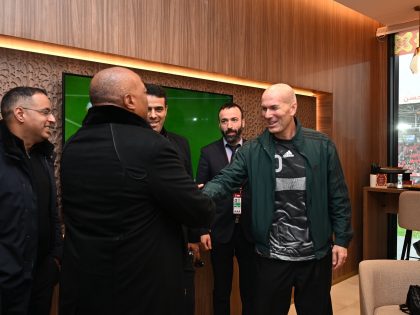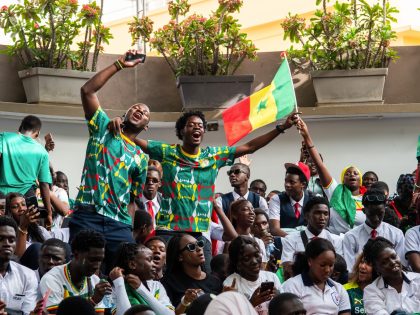The limits of the idea of “alternative Africas”
How much energy should we invest in counterfactuals like: What if a diminished Europe, devastated by a plague, did not produce colonial powers, how might Africa’s history have unfolded?

Alkebu-lan 1260, by the Swedish artist, Nikolaj Cyon.
Hard on the heels of an anti-climactic election season in the US punctuated by myopic views of the world and cataclysmic what-ifs, the resurgence of Nikolaj Cyon’s counterfactual map of Africa circulating on the web last week was a welcome relief from realpolitik run amok.
Cyon, a Swedish artist and self-proclaimed revolutionary, asks us to think back to the fourteenth century and imagine the ravages of the Black Death to have been worse than they were, a demographic catastrophe so severe that Europe’s recovery was insufficient to restore vibrant economic life, let alone generate the impetus for maritime adventures. To follow Cyon’s logic: a diminished Europe would not have produced colonial powers. How then might Africa’s history have unfolded?
I’ll admit, my first reaction to the map was more puzzled than entranced. Some of the units Cyon depicts are familiar language communities, some are historical kingdoms, others represent economic or trading relationships, while a fourth category extrapolates wildly different outcomes from historical kernels (why the fanciful Al-Magrib instead of the imagined growth of an actual Moroccan kingdom such as the Almoravid or the Sa’dian, for example?) But seeing this only as miscued scholarship limits our perspective.
As art, the map is more inviting. I don’t worry that Picasso’s Demoiselles d’Avignon don’t really look like women. If I don’t worry about a historian’s obsession with accuracy, what can I take away from Cyon’s evocation of a Europe-free African history? The greater presence of Arabic names and Muslim-influenced political structures makes sense, as does the diversity of political forms. But would the Swahili city-states have consolidated into a single polity? Would Merina or Dahomey have been large kingdoms without the slave trade? Questions, rather than criticisms, come through and I am reminded of issues I always want my students to grapple with: today’s geopolitics were not inevitable; contingency matters in the study of history.
But there are other, difficult realizations that Cyon’s upside down Mercator projection, colored with a palette surely intended as reminiscent of historical, colonial maps, cannot banish. Our reality conditions—and limits—the alternative worlds we imagine. Even the best science fiction has to connect to elements of lived experience (Frank Jacobs at Think Big explicitly connects Cyon’s project to Kim Stanley Robinson’s The Years of Rice and Salt.) Eurocentric presumptions, and ideas deeply rooted in the production of western knowledge are part of the inescapable reality of both Cyon and his audience.
Debating whether or not Bujumbura would have been a capital without European intervention misses the mark. Eurocentrism runs much deeper. This project, although it depicts a markedly altered political landscape, sits comfortably within the norms of western geospatial understanding. Like Martin Lewis and Kären Wigen’s Myth of Continents, Cyon’s map productively disrupts conventional spatial representation. Cyon’s counterfactual vision reminds us that naming conventions—Africa, the Atlantic Ocean—are constructions and not inherent in the place. The map also shows that colonization and its aftermath were not inevitable, but it doesn’t imagine an alternative to bounded sovereign territories. Even without the Westphalian state system translocated through imperial adventure, we’re still looking at a map of contiguous states.
Given what we know about African state formation and territoriality, why presume a map that is completely filled in with claimed land? Both IMartin Lewis and Kären Wigen have painted pictures of African pasts with fluid boundaries and plenty of interstitial spaces. Granted, the Atlantic slave trade and colonization directly account for Africa’s “under-population” relative to terrain and compared to other regions, but imagining an alternative future free of those legacies might speculate about a political-economic order that did not allocate every square meter of space to an administrative unit.
Even more imaginatively, how might we visually represent polities constituted by people rather than territory? Since people, even farmers, are not permanently rooted in the ground, our mapping project begins to look very different. Both Tongchai Winichaikul and J.B. Harley reveal the pervasive cultural frameworks embedded in visual representations of space, politics, and human relationships—representations that we call maps. This visual register bounds the possibilities of communication as much as our linguistic limitations do. Cyon’s Alt-Africa map is arresting and provocative, but it can only go so far.
I can’t think or talk about Africa except through the veil of a specifically western epistemology. It’s not just that the languages in which I can converse are Indo-European. Improving my grasp of isiXhosa won’t get around the other stumbling blocks in my head, a set of assumptions about the way the world is ordered, and knowledge produced. I can’t just set that aside without unraveling the rest of the stuff in my brain.
Like everyone, I walk around with a set of cultural presumptions inherited from the community in which I was raised. A liberal arts education simultaneously helped me develop tools with which to perceive hidden transcripts and implicit power structures while also disciplining other presumptions firmly into place. I can suspend—at least for a little while—my reluctance to think about language groups, kingdoms, and trading networks as equivalent geographical spaces. I might disagree with some of Cyon’s presumptions about how a Europe-free history of Africa would have played out, but the fact that we can debate those presumptions, or together read the map he produced and come to different conclusions speaks directly to the western epistemology we share—and can’t shake. I want to push Cyon to check more of his Eurocentrism at the door, but as long as we’re both talking about Africa as a place he and I might reimagine, it’s clear that legacies of dominance rooted in histories of conquest persist.



















